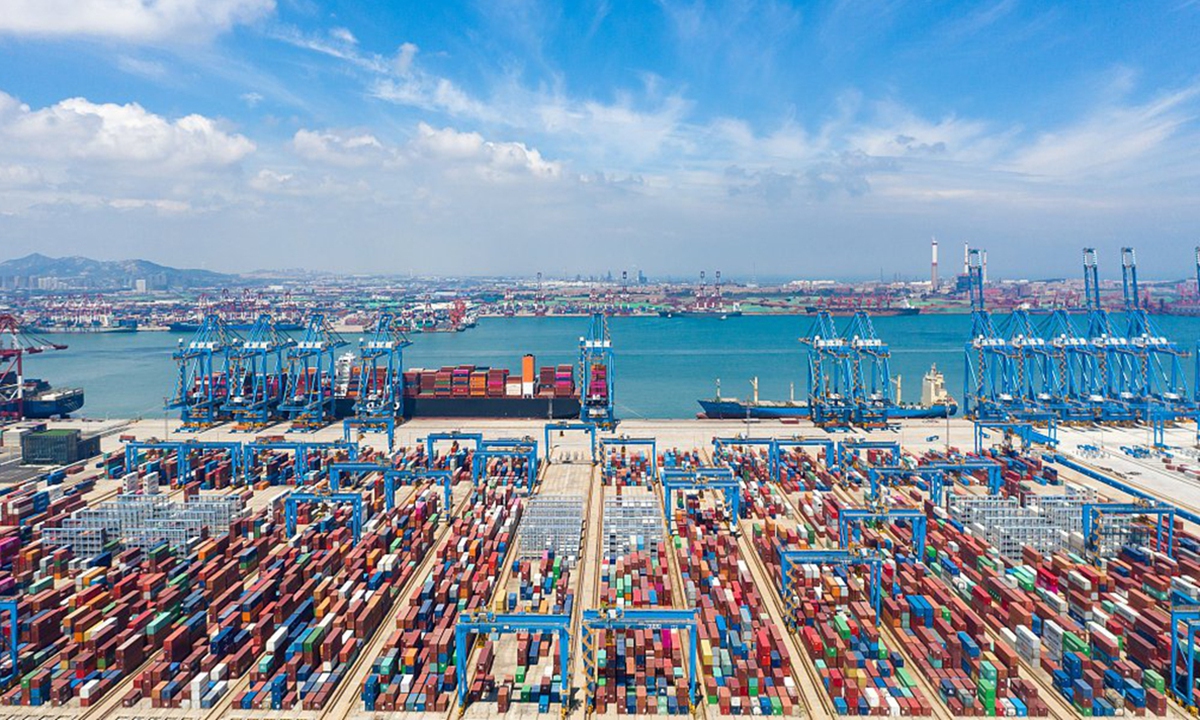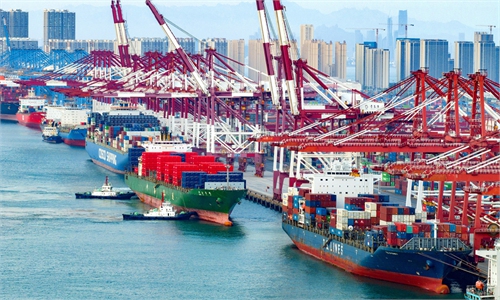
China trade economy File photo: VCG
China's foreign trade in goods reached a historical high of 20.1 trillion yuan ($2.8 trillion) in the first half of 2023, up 2.1 percent year-on-year, showing resilience in the face of a complex international landscape, as the country witnessed improvement in trade quality amid a continuing economic recovery and industrial chain upgrading.
China's foreign trade has maintained steady growth in the first half of the year. Trade with emerging markets continued to grow, according to statistics released by the General Administration of Customs (GAC) on Thursday.
The country's imports and exports reached 9.76 trillion yuan in the first quarter and 10.34 trillion yuan in the second quarter, both registering positive growth year-on-year. Imports and exports in the second quarter were 6 percent higher than in the first quarter.
It can also be seen from the statistics released by the GAC that imports and exports of private enterprises have been growing. The proportion of electro-mechanical products in exports increased and imports of commodities and consumer goods witnessed rapid growth.
In the first half of 2023, imports and exports of China's private enterprises increased by 8.9 percent to 10.59 trillion yuan, accounting for 52.7 percent of the country's total. Imports and exports of foreign-invested enterprises came to 6.16 trillion yuan, accounting for 30.7 percent.
Total exports increased by 3.7 percent year-on-year to reach 11.46 trillion yuan in the first six months. Exports of electro-mechanical products increased by 6.3 percent to 6.66 trillion yuan, making up 58.2 percent of exports, 1.4 percentage points higher year-on-year. Of these, exports of electric vehicles, lithium batteries and solar cells increased by 61.6 percent, driving the overall export growth of 1.8 percentage points, according to the GAC.
Although China's imports slightly declined 0.1 percent year-on-year to reach 8.64 trillion yuan, imports of bulk commodities increased rapidly by 17.1 percent. Of these, China imported 561 million tons of energy products including crude oil, natural gas and coal, up 33.2 percent. Imports of consumer goods increased by 6.6 percent to 974.84 billion yuan, while imports of meat grew by 9.5 percent and edible aquatic products by 30 percent.
It is worth noting that China's trade with partners in emerging markets continued to rise in the first half of the year.
Foreign trade with countries involved in the China-proposed Belt and Road Initiative (BRI) grew by 9.8 percent, 7.7 percentage points faster than overall foreign trade, accounting for 34.3 percent of total foreign trade.
During the same period, trade with the Association of Southeast Asian Nations (ASEAN), China's largest trading partner, came to 3.08 trillion yuan, up by 5.4 percent year-on-year, accounting for 15.3 percent of total foreign trade.
Trade with trading partners involved in the Regional Comprehensive Economic Partnership (RCEP) grew by 1.5 percent. Meanwhile, trade with Latin American countries increased by 7 percent and that with African countries increased by 10.5 percent.
China's trade with the EU grew by 1.9 percent to 2.75 trillion yuan, accounting for 13.7 percent of total foreign trade, while trade with the US dropped 8.4 percent, accounting for 11.2 percent of the total.
In the first half of 2023, foreign trade withstood external pressure and saw an improvement in quality. On the whole, the performance of foreign trade in the first half of the year was in line with expectations, Lü Daliang, a spokesperson for GAC, said on Thursday at a press conference.
Speaking of the growth rate in the foreign trade sector, Zhou Maohua, a macro economist from China Everbright Bank, said that the global economic slowdown and China's high foreign trade base in 2022 have dragged down growth, though growth was already greater than expected.
"Foreign trade has declined sharply in some surrounding economies, while China maintained expansion in the sector, fully showcasing China's resilience," Zhou told the Global Times on Thursday.
Foreign trade is still expected to maintain moderate growth throughout the year, as the global economy is still expected to maintain a low rate of expansion, coupled with China's foreign trade resilience, said Zhou.
Confidence remains
"As for foreign trade in the second half of the year, we feel both pressure and confidence," Lü said.
Lü noted that at present, inflation in major developed economies is still at a high level, geopolitical conflicts are continuing and there is not enough short-term external demand to pick up momentum. China's foreign trade is still facing greater pressure for steady growth.
However, the fundamentals of China's economy are resilient and show great potential. With a series of policy measures continuing to take effect, we have the confidence, foundation and conditions to achieve the goal of promoting stability and improving the quality of imports and exports, the GAC spokesperson stressed.
"Throughout 2023, we are confident that we will continue to consolidate our market share and maintain China's position as the largest country in the global trade in goods," said Lü.
Industry insiders and analysts also said they have confidence that China's foreign trade will grow in the second half of the year.
"I always believed in the overall resilience of China's foreign trade, especially when it maintained growth in such a complex economic environment. Since March and April of this year, the economy has been picking up, and our orders are also recovering," Zhu Qiucheng, CEO of Ningbo New Oriental Electric Industrial Development, an exporter of pet furniture and home furnishing products, told the Global Times on Thursday.
Zhu said that the growth rate of foreign trade in the first half of the year was within expectations, as China's foreign trade sector is undergoing a structural upgrade, which means that high value-added products are taking an increasing share of total trade, especially in exports.
New driving forces
The core point of foreign trade growth this year is in new markets, such as Latin America, ASEAN, and countries involved in BRI and RCEP, industry insiders said.
"We witnessed huge growth in exports to South Korea, Latin America and Russia in the first half of the year," said Zhu, adding that his company has been cooperating with an e-commerce platform in Russia and was in talks with e-commerce platforms in Latin America.
A Yiwu-based logistics agent surnamed Yu told the Global Times that their customers' major export destinations were Russia and Belarus, but they have expanded their business to Southeast Asia given the increasingly close ties between China and ASEAN and RCEP members.
"We opened a new warehouse in Guangzhou, [South China's Guangdong Province], with an area of over 10,000 square meters. It is closer to Southeast Asia than Yiwu [in East China's Zhejiang Province]. Currently, we export containers on about two to five China-Europe freight trains every month," said Yu.
Cross-border e-commerce will definitely be the largest increment of foreign trade in the next five years, noted Zhu, who has been in the e-commerce industry for about 20 years.
In fact, cross-border e-commerce already showed huge growth in the first half of 2023. According to the GAC, foreign trade volume through e-commerce stood at 1.1 trillion yuan, up 16 percent year-on-year. Of these, exports through e-commerce increased by 19.9 percent to 821 billion yuan, while imports came to 276 billion yuan, up 5.7 percent.
According to an estimate sent to the Global Times from DHGATE, the first B2B cross-border e-commerce platform in the country, it is predicted that China's B2B cross-border e-commerce export market will reach 13.9 trillion yuan in 2025.

